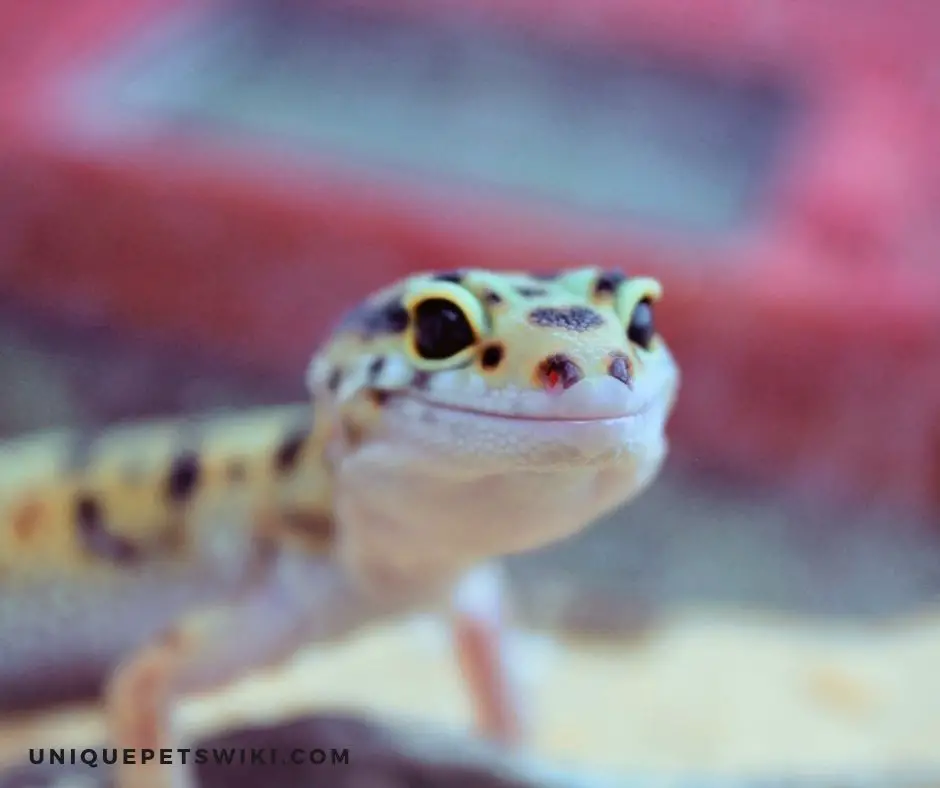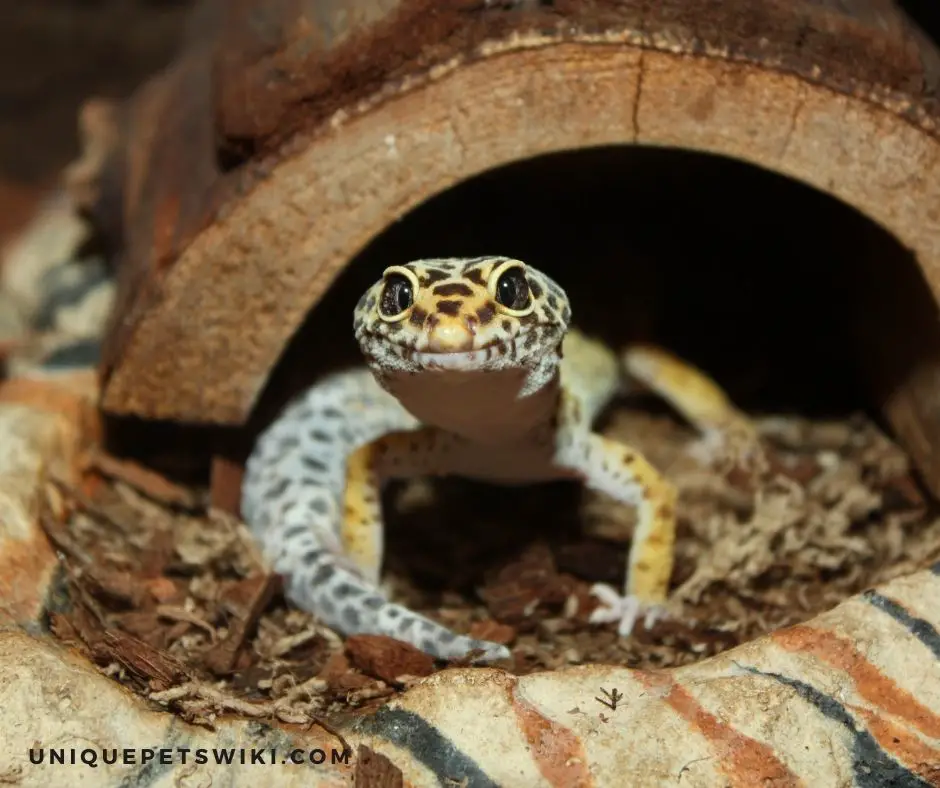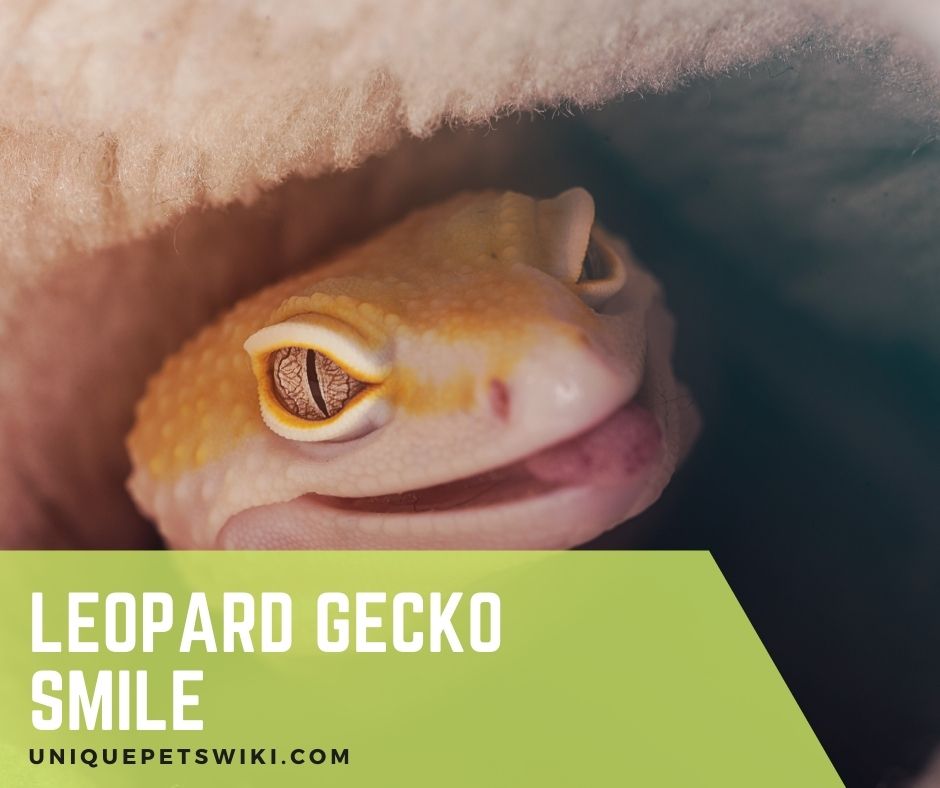If you’re new to Leopard Geckos smiles, let’s walk you through all that you need to know.
You might be wondering, do they truly smile? Does their smiling face always mean that they’re happy? Let’s find out.
One of the most interesting and beautiful reptiles to keep as a pet is a leopard gecko. Not only because of their smiling face but also their docile nature.
They are known for always wearing this smiley look on their faces, which may calm your stress if you have them as pets.
Because of their smiling face, many people generally believe that leopard geckos are happy animals and are never sad. This is false because these creatures do not have a choice whether to smile or not.
Besides, they don’t have emotions to express happiness as humans do. Hence, their smiling face isn’t attributed to emotions.
You might begin to wonder if their smiles aren’t related to emotions, what then makes them smile the way they do? You might also want to know if their smiles aren’t attributed to moods, how can you tell if they’re happy or not?
Relax! This article is designed to give answers to some questions in your mind.
This article has been reviewed by Dr. Gospel. Read more about our knowledge control process here.
Contents
Leopard Gecko Smile: Do They Actually Smile?
Leopard Geckos are small adorable lizards. They are commonly kept as pet animals because of their peaceful nature and unique physical look. They come in various beautiful skin colors with dark brown spots like that of a Leopard which gives them the name ‘Leopard Geckos’.
There is this one amazing feature of Leopard Geckos that draws people’s attention to them. That Is Their Smiling Faces.
Leopard Geckos are naturally smiling animals. They are born that way.
What does it mean then? Let’s find out in the next section.
What Makes Leopard Geckos Smile?
As earlier stated, Leopard geckos smile not because they want to, but because they are created with a physical facial expression that looks like a smile.

Their smiling faces are natural. This is because their lips are naturally pushed far apart extending to both sides of the ear, giving them the look of a wide smile.
It does not have anything to do with their emotions whether happy or sad. Unlike humans who can smile as a way of expressing happiness and excitement and can also conceal their smile when they are sad.
The only thing these creatures can do is to keep wearing their smiling faces even if their husbandry is faulty.
Can You Tell If Your Leopard Geckos Are Happy When They Smile?
No, you can’t tell if leopard geckos are happy from their smiles. Judging their happiness from their smiling face would be misleading.
The only emotions leopard geckos and other reptiles have is fear and aggression. Therefore don’t mistake the smiley face for happiness.
You need to understand that having a leopard gecko requires that you study them well enough to detect when something is going wrong with them. To achieve this, you must have the habit of looking past their smiling face.
This Means that To Tell If Your Pet Leopard Gecko Is Happy Or Not, You Must Understand Its Behaviors.
How To Tell If Leopard Geckos Are Happy Or Not?
According to research by Dr. Greg Pauly, it is difficult to interpret a lizard’s emotions when it comes to expressions of happiness and pleasure, because they do not have the same behaviors as a dog wagging its tail or a cat purring.
However, leopard geckos express their positive emotions of pleasure, happiness, and excitement by rattling their tail. They display this behavior whenever you caress them or give them food. With that, you can easily tell that it is happy.

Dr. Pauly also added that the most “widespread positive behavior” would simply be that a lizard appears calm. If your leopard gecko is resting, breathing slowly, and not engaging in any defensive behaviors, then these are all positive behaviors.
More so, leopard geckos would also express displeasure when they are stressed or faced with poor husbandry. Some examples of husbandry related factors that can make leopard geckos happy and unhappy include:
Poor Diet
Leopard geckos are known to be lovers of food. In fact, some breeders during an interview said that their geckos are gluttons. In the wild, they feed on a variety of prey items such as crickets, wax moths, larvae, grasshoppers, nesting mice, and small locusts.
In captivity, they eat small vertebrate prey if given the opportunity, including spiders, beetles, crickets, worms, cockroaches, wax moths, centipedes, scorpions, etc.
Juvenile Leopard Geckos will eat small crickets and mealworms daily. The young adults will eat medium-sized crickets, mealworms, and wax worms. Adults will eat large crickets, wax worms, and mealworms.
That said, if you’re feeding your lizard sparingly or not offering varieties, this may cause some displeasure to your pet.
As part of an optimal care need, you must provide them with fresh and clean spring water in a shallow bowl that cannot be tipped over. Also, ensure that you change and clean up their water bowl.
Inappropriate Enclosure Size And Set Up
Leopard geckos are natural inhabitants of rocky, dry grasslands. They originated from the arid and semi-arid deserts of Asia, Northern India, Pakistan, and Iran.
Therefore, going by their natural environment, they love a warm and dry environment. For them to be happy and healthy, you need to provide them with an enclosure that simulates their natural habitation.
While doing that, ensure that you’re using the appropriate enclosure size. An ideal terrarium size for a juvenile should be a 10-gallon tank and must be well ventilated. Adult leopard geckos can thrive in a 20-gallon tank.
If you are keeping more than one leopard geckos, it is advisable you house them separately to avoid stress from confrontation.
Leopard geckos are solitary creatures, and having more than one in the same enclosure will not end well no matter how good you think they are getting along.

Cage Temperature
Leopard geckos love warm and dry climates just like they would have in the wild. Since they’re ectothermic, you should provide an enclosure with a temperature gradient of 88–92 on the warm side and 75 – 80 on the cool side.
An under-tank heat mat will achieve this, but it is necessary to have a thermostat attached to ensure that the heat mat will not get too hot and burn their bellies.
Avoid using a heat lamp because it can be very harmful to your pet gecko and can even go as far as causing burns and vision impairment.
You can also get a hygrometer to measure the humidity to keep it in that 10% to 30% range, which is ideal for leopard geckos.
Poor Substrate
Poor substrates can also cause discomfort to your pet leopard gecko. The substrate needs to be natural.
Sandy substrates can cause impaction, while reptile carpet can catch on claws and teeth as well as harbor bacteria. Good options for a substrate include paper towels, non-adhesive shelf liner, newspaper, and tiles.
Poor health
A healthy and happy leopard gecko has clear, bright eyes and a thick tail and its belly should only touch the floor when resting. Anything other than this will cause your pet displeasure.
After you’ve gotten your leopard gecko and helped it to settle in its new environment, it is wise to have them examined by a veterinarian to ensure that it is free from disease.
Always watch them closely in case moving in has stressed them out or make them fall sick. Contact your veterinarian immediately when you see strange behavior.
Some signs of illnesses include:
- Hiding more than usual.
- Eating or drinking less.
- Weight loss.
- Swollen joints.
- Abnormalities with the eyes, nose, or mouth.
- Discolored skin and noticeable shedding problems.
- Abnormal droppings for more than two days.
- Not pooping for extended periods of time.
Do Leopard Geckos Always Smile?
Since they are naturally created with a smiling face, they will always smile right from when they’re born to when they die. Even when they’re scared.
Wrapping UP
Leopard geckos are one of the most common lizard pets, ideal for both beginners and experienced keepers. One can say that they are the first domestic animal from the reptile family. They are portable, robust, and also very easy to care for.
Leopard geckos are known for their unique and beautiful curved lips which look like a smile, therefore giving them a natural smiling facial appearance all the time.
And this has given most people the impression that these adorable lizards are always happy. But this isn’t true as it is seen in this article.
Leopard geckos display certain behaviors to show that they are happy, and when they are not comfortable there are behaviors that show something has gone wrong with them.
Most importantly leopard geckos get healthy and happy when you provide them with an enclosure that simulates their natural habitat.
In a nutshell, we can say that their smiling facial appearance is more of a natural physical phenomenon of animals of their kind. And doesn’t have anything to do with emotions, whether they are happy or not.
